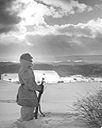
 |
Sweden Utopia Sweden already saw itself as a major power of humanity at the end of the First World War. This image of a peaceful oasis on the edge of Europe became even more firmly established during and after World War II when it was decided to preserve neutrality at all costs. The Swedish soldier keeping guard at the border became the motif for the most important image of national self-portrayal. Neutrality, which would be defended with arms if necessary, was an even more valuable possession. This self-image was contrasted with images of suffering, destruction and moral corruption in the countries at war and the occupied territories. Neutral Sweden took the position of defender of the weak and of humanity against the madness of war. A constant factor in Swedish self-perception was its commitment in the service of human rights, humanity and compassion. After the War Sweden was the only country in Europe that was able to provide help, according to the official interpretation. This was seen as a direct achievement of the policy of neutrality. Now as then, the combination of neutrality and humanity is a central component of the official self-image of Sweden. |
| An example of the connection between the leitmotif of neutrality and the figure of the "soldier on guard duty" could already be found in the feature film "Alle man på post" ("Everybody at his Station") from 1940. The motif was also present in postcards, as photographs or drawings in newspapers, on posters and in newsreels. A typical example is this photograph of a soldier braving ice and snow to defend his country. The photo is the prototype of all the pictures that followed. Characteristic for the composition of these images is their low visual angle before a typical Swedish landscape. The scenery, a symbolic background for the figure of the soldier, reinforces the message of the images. The determined will of the soldier to defend all Sweden serves to mitigate other images of the imminent war. The open sky becomes a meaningful setting and loses its potential threat as a scene of enemy air attacks. |
|
| The motif of the soldier on guard was taken over again in 1999, still with no change of interpretation. It appears as a motif in a postage stamp series under the title "Our 20 th Century". This is the only stamp in the series to refer to the war years. The familiar silhouette of the Swedish guard soldier is outlined against a night sky dramatically illuminated by anti-aircraft searchlights. The silhouette is from the cover page of the sheet music of Ulla Billquist's "Min soldat". The song title is also noted on the stamp. The singer herself seems to appear to the eternally steadfast soldier like a fantasy in the night sky. This is the only postage stamp in the series that does not depict its subject matter directly, but rather in a roundabout way. The symbolic image of war seems to be the only access for a nation that used all available means to keep itself out of the Second World War but nevertheless had to develop an identity in relation to it. |
|





